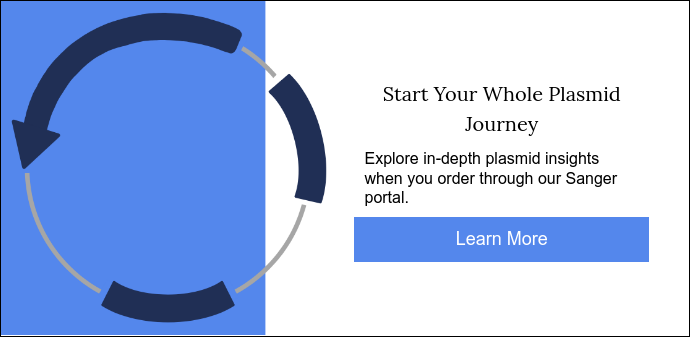What Is Whole Plasmid Sequencing?
Whole plasmid sequencing is a long-read sequencing technique that reads all of the DNA present in a plasmid. Because whole plasmid sequencing uses nanopore technology, it sequences millions of DNA fragments simultaneously. This makes it possible to characterize the full plasmid in a relatively short time.
In comparison, Sanger sequencing is the other most common method of plasmid sequencing. This technique uses primers to sequence small segments of DNA, then pieces those fragments together into longer sequences.
Sanger sequencing does not typically analyze the entire plasmid. The size of plasmids makes Sanger an unrealistic method for full plasmid sequencing. Instead, Sanger sequencing focuses on the insert region of the plasmid. This is not as effective when it comes to identifying structural problems in the plasmid, or when comparing the content of the plasmid to a reference sample.
Benefits of Whole Plasmid Sequencing
Access long reads
With improved library prep chemistry, whole plasmid sequencing (WPS) can characterize an entire circular plasmid with one long read. Historically, long reads were less accurate than short read sequencing — requiring a lengthier, more expensive process to obtain the same data. Improvements in chemistry, however, have made long read a faster, accurate method for plasmid sequencing.
Skip the primer step
Primers are short segments of nucleic acids (typically between 18 and 24 bases) that provide a starting point for DNA synthesis. Primer design and manufacturing is an additional step to sequencing that can significantly impact TAT. Despite the high quality design tools widely available, primers may still not perform well in the sequencing reaction for any number of other reasons.
Psomagen’s whole plasmid sequencing workflow does not require primers to generate long-read sequencing data. This eliminates a time-consuming step and creates a more streamlined process for sequencing projects.
Sequence faster
Compared to primer walking, whole plasmid sequencing is a much faster alternative. With whole plasmid sequencing, it is possible to obtain a complete sequence in about a day. Turnaround time will still vary based on the lab. Psomagen, for example, offers a turnaround time of 16 to 24 hours for WPS.
What Can You Do With Whole Plasmid Sequencing?
Sequence difficult regions
Whole plasmid sequencing makes it possible to analyze difficult regions of genetic material. Challenging regions for sequencing include GC-rich regions and repetitive sequences that would otherwise be missing in the final data.
Identify microbes
In the past, long sequencing TATs were prohibitive to using the technology for the majority of point-of-care infectious disease diagnostics. With the this new technology that can rapidly identify pathogens, including anti-microbial resistance genes, within a few hours, WPS is poised to improve patient health by treating with the right drug, right away. This is an important tool for understanding bacterial evolution, antibiotic resistance, and other elements of pathogenic research.
Whole plasmid sequencing also opens the door for faster, more accurate diagnostics. A 2022 Norwegian study proved that whole plasmid sequencing is an effective tool for pathogenic identification and disease resistance detection.
The technology successfully identified E. coli and K. pneumoniae diluted into blood cultures. Researchers completed their identifications within 1000-3000 bases from the start of sequencing-some samples were even identified in as little as 10 minutes!. This is a promising result for medical environments where it is essential to decrease diagnostic time and begin treatment as soon as possible.
Explore structural instability
Traditional plasmid sequencing often focuses on the inserted region of DNA, not the rest of the plasmid structure. WPS can identify degradation of genetic material or structural changes that occur during replication that could be missed by other approaches.
When researchers use plasmids to develop disease treatments, pDNA stability is a crucial factor. By identifying and overcoming these structural instabilities, researchers can develop safe and effective molecules for the treatment of many diseases.
Whole plasmid sequencing is a valuable tool for drug discovery, gene therapy, and disease modeling. With a more complete view of plasmid structure, researchers can make discoveries in translational research and molecular diagnostics. This technology is fast, accurate, and affordable — while offering a more thorough picture of the plasmid's genetic material.
Psomagen has recently added whole plasmid sequencing to our list of services! Get next-level discoveries when you make your first order with us.



